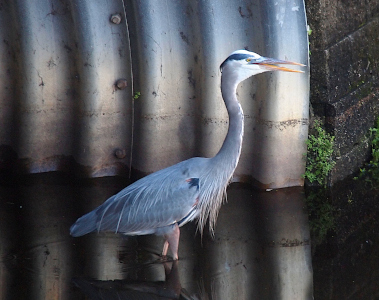More adult great blue herons.
page 2 of 2
- - - - - - - - - - - - -
A heron on the prowl.
![[A very close view of a heron's head and part of its bill. The rest of the body is hidden by the foilage in between me and the bird.]](Photo-herons/20150304 - great blue heron 3.jpg)
The heron is focused on its prey.
![[A close view of the back of the head and neck of a heron.]](Photo-herons/20150304 - great blue heron 1.jpg)
The long legs of this great blue heron are almost completely submerged.

This heron has very recently swallowed something rather large.
Its tongue is visible in this shot as is the widened neck.
![[A heron stands on the ground with its mouth open slightly and its tongue visible in its mouth. Its neck looks as if it just swallowed a wide fish.]](Photo-herons/20151012 - great blue heron 3.jpg)
The same bird a few moments later. Whatever it ate must be going down the hatch properly.
![[A heron stands on the ground with its mouth open and its head bend forward. There doesn't appear to be any difference in the size of the throat or neck so the system must be working.]](Photo-herons/20151012 - great blue heron 9.jpg)
A close view of a different great blue heron with its tongue visible
![[Side view of the head of a heron facing left with its bill open and the pink tongue elevated above the lower bill. The tongue extends a little more than half the length of the bill. Top bill is mostly blue while the lower bill is yellow.]](Photo-herons/20231021 - great blue heron.jpg)
This bird seems to be announcing its presence.
![[A heron is walking toward the camera with its mouth open. One foot is on the ground and the other is in the air.]](Photo-herons/20151010 - great blue heron 1.jpg)
It seems all creatures get itches.
![[A heron stands on one leg with its head forward and the other foot in the air with one toe scratching under its chin.]](Photo-herons/20151012 - great blue heron 17.jpg)
A female anhinga and a great blue heron.
![[An anhinga stands in front of a great blue heron. The heron is facing the water while the anhinga is facing the opposite way with her wings open to dry her feathers. The anhinga isn't much taller than just the herons legs.]](Photo-herons/20150401 - great blue heron and anhinga 1.jpg)
An ibis, a roseate spoonbill, and a great blue heron hunting for breakfast.
![[All three birds stand in the water. The ibis is fluffing its back feathers. The roseate spoonbill stands on one foot. The great blue heron is closer to the camera.]](Photo-herons/20150813 - blue heron roseate spoonbill ibis 3.jpg)
Resting in a tree about 15 feet above the water.
![[The left side of a heron's body is visible except for the lower portion of its legs. It is completely surrounded by leaves as well as leaves in front of its legs.]](Photo-herons/20170604 - great blue heron 2.jpg)
Return to page 1 of 2 to see the juvenile heron.
Return to wildlife photos index.
All photos © S. M. Garver